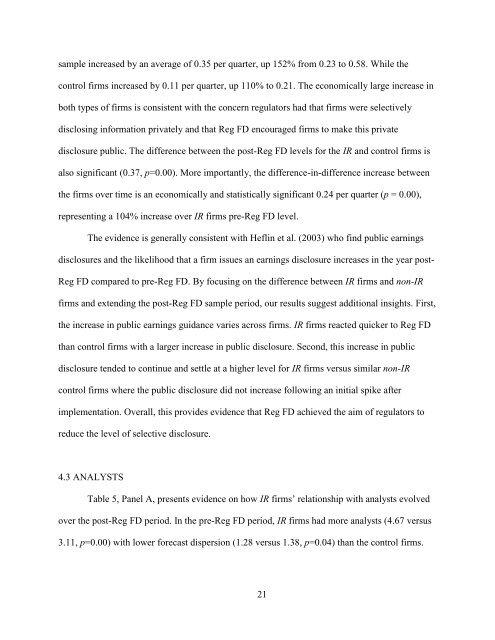Investor Relations and Regulation FD
Investor Relations and Regulation FD
Investor Relations and Regulation FD
Create successful ePaper yourself
Turn your PDF publications into a flip-book with our unique Google optimized e-Paper software.
sample increased by an average of 0.35 per quarter, up 152% from 0.23 to 0.58. While the<br />
control firms increased by 0.11 per quarter, up 110% to 0.21. The economically large increase in<br />
both types of firms is consistent with the concern regulators had that firms were selectively<br />
disclosing information privately <strong>and</strong> that Reg <strong>FD</strong> encouraged firms to make this private<br />
disclosure public. The difference between the post-Reg <strong>FD</strong> levels for the IR <strong>and</strong> control firms is<br />
also significant (0.37, p=0.00). More importantly, the difference-in-difference increase between<br />
the firms over time is an economically <strong>and</strong> statistically significant 0.24 per quarter (p = 0.00),<br />
representing a 104% increase over IR firms pre-Reg <strong>FD</strong> level.<br />
The evidence is generally consistent with Heflin et al. (2003) who find public earnings<br />
disclosures <strong>and</strong> the likelihood that a firm issues an earnings disclosure increases in the year post-<br />
Reg <strong>FD</strong> compared to pre-Reg <strong>FD</strong>. By focusing on the difference between IR firms <strong>and</strong> non-IR<br />
firms <strong>and</strong> extending the post-Reg <strong>FD</strong> sample period, our results suggest additional insights. First,<br />
the increase in public earnings guidance varies across firms. IR firms reacted quicker to Reg <strong>FD</strong><br />
than control firms with a larger increase in public disclosure. Second, this increase in public<br />
disclosure tended to continue <strong>and</strong> settle at a higher level for IR firms versus similar non-IR<br />
control firms where the public disclosure did not increase following an initial spike after<br />
implementation. Overall, this provides evidence that Reg <strong>FD</strong> achieved the aim of regulators to<br />
reduce the level of selective disclosure.<br />
4.3 ANALYSTS<br />
Table 5, Panel A, presents evidence on how IR firms’ relationship with analysts evolved<br />
over the post-Reg <strong>FD</strong> period. In the pre-Reg <strong>FD</strong> period, IR firms had more analysts (4.67 versus<br />
3.11, p=0.00) with lower forecast dispersion (1.28 versus 1.38, p=0.04) than the control firms.<br />
21
















